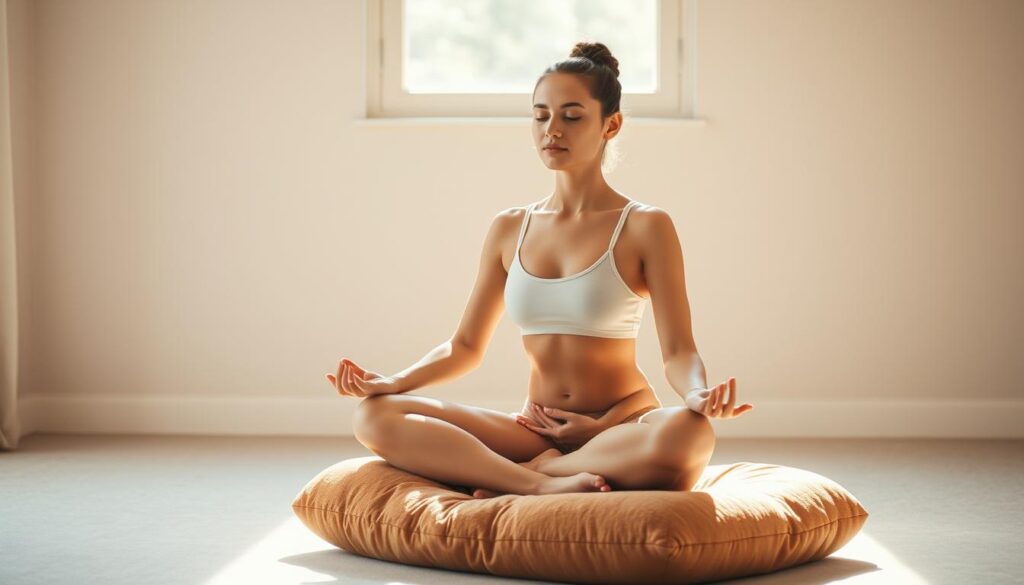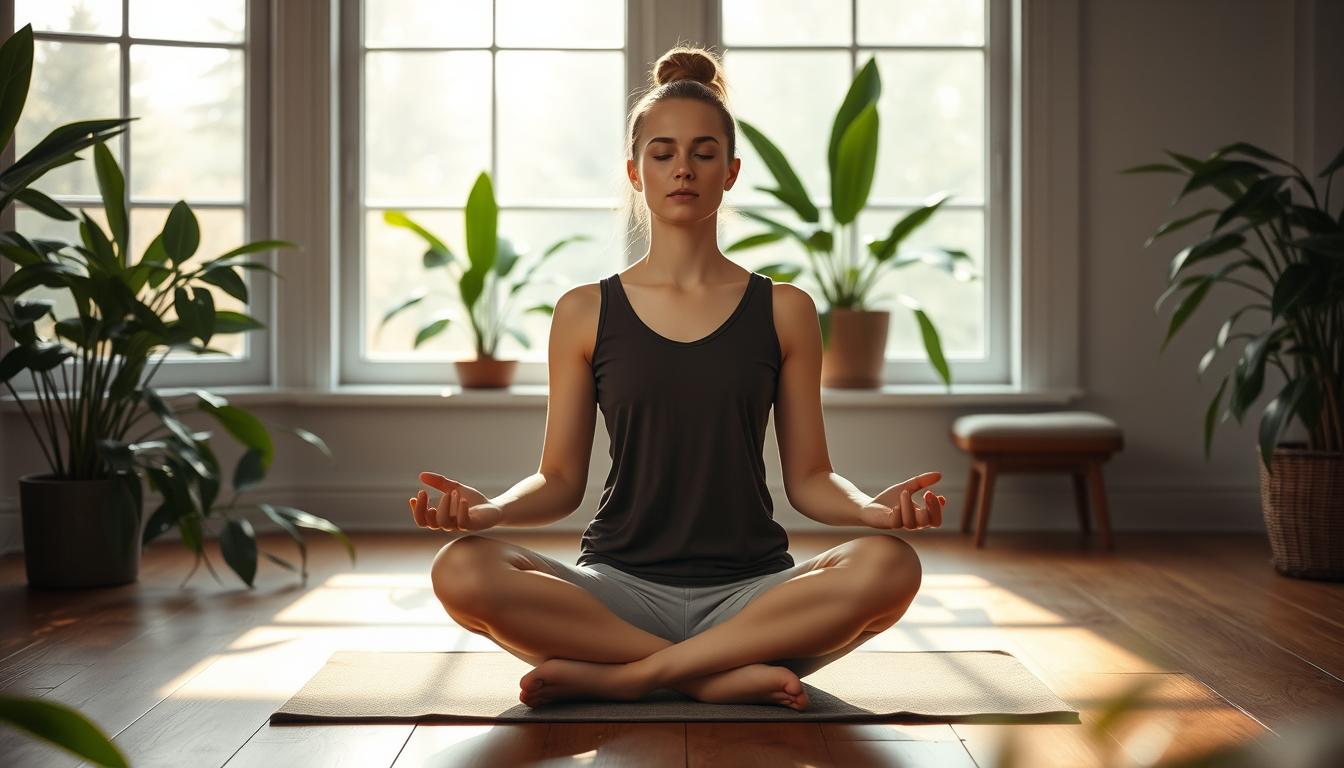I still remember the first time I tried meditation – I was frustrated because my mind wouldn’t stop racing.
But as I continued to practice, I realized that it’s not about achieving a completely blank mind; it’s about learning to be present with our thoughts.
In today’s fast-paced world, meditation is a powerful tool to help us pause, breath, and reset. It’s not a mystical practice reserved for a select few; it’s a simple technique that beginners can start with tips from this guide to get started.
Key Takeaways
- Understand that meditation is a practice, not a perfection.
- Learn simple techniques to calm your mind.
- Discover how to incorporate meditation into your busy schedule.
- Find out the benefits of regular meditation practice.
- Get practical tips for starting your meditation journey.
What is Meditation and Why Should You Try It?
When it comes to meditation, many of us are unsure of what it entails and what we can gain from it. As we explore this practice, we will clarify what meditation is and dispel some common misconceptions.
Meditation is a practice that involves focusing the mind to achieve a state of calm and clarity. It is a method to cultivate mindfulness and awareness, helping us become more aware of our thoughts without being controlled by them.
Defining Meditation in Simple Terms
In simple terms, meditation is a mental workout that helps you become more aware of your thoughts. It is a technique that trains the mind to concentrate and redirect thoughts, often towards the breath, which serves as an anchor. This practice is not about achieving some mystical state but rather about being present in the moment.
- Meditation is not about emptying your mind completely, but about noticing when your mind wanders and gently bringing it back.
- It is not necessary to sit for hours in uncomfortable positions; even 5-10 minutes in a comfortable chair can be effective.
- Meditation is a skill that anyone can learn, and it is not tied to any specific religion or spiritual practice.
Common Misconceptions About Meditation
Some common misconceptions about meditation include the idea that it is tied to specific religious or spiritual practices, or that it requires a lot of time and a particular posture. In reality, meditation is a versatile practice that can be adapted to fit into our daily lives. The goal of meditation is not to stop thinking but to change our relationship with our thoughts—observing them without judgment.
By understanding what meditation is and clarifying some common misconceptions, we can see that it is a beneficial practice that can help us respond thoughtfully rather than react automatically to life’s challenges. As we continue to explore meditation, we will see how it can be a valuable tool for improving our overall wellbeing.
The Science-Backed Benefits of Meditation
The science is in: meditation offers numerous benefits for both body and mind. With over 1,500 research studies to back it up, it’s clear that incorporating meditation into your daily routine can have a significant impact on your overall wellbeing.
Reducing Stress and Anxiety
Meditation has been shown to be effective in reducing stress and anxiety. According to a 2014 literature review of 47 trials, mindfulness meditation programs demonstrated “moderate evidence of improved” anxiety and depression. Regular meditation practice helps reduce cortisol (the stress hormone) and activates the parasympathetic nervous system, promoting relaxation. As noted in a study by Harvard researchers, mindfulness may change the brain in depressed patients, underscoring its potential benefits for mental health.
Improving Focus and Memory
Meditation can also improve cognitive function, particularly in areas such as attention and memory. A 2019 study found that participants who practiced daily guided meditation for eight weeks showed “enhanced attention, working memory, and recognition memory.” This improvement can be attributed to the increased gray matter in areas of the brain associated with self-awareness, compassion, and memory. By incorporating meditation into your daily routine, you can potentially see improvements in your focus and memory.
Enhancing Sleep Quality and Overall Wellbeing
Furthermore, meditation has been linked to improved sleep quality. A 2014 study involving individuals with chronic insomnia found that after eight weeks of intensive meditation-based treatments, participants experienced a reduction in “total wake time and pre-sleep arousal,” leading to better sleep habits. Meditation helps calm the mind, breaking the cycle of insomnia and promoting overall wellbeing. By regulating emotions and creating space between stimulus and response, meditation allows for more thoughtful reactions to life’s challenges.
As Sherwin notes, “There’s hard science that backs up how beneficial meditation is.” With consistent practice, these benefits can begin to manifest in as little as eight weeks, though some individuals may notice positive changes sooner. By making meditation a part of your daily routine, you can start experiencing the benefits for yourself.
The Best Way to Meditate: A Step-by-Step Guide for Beginners
If you’re new to meditation, you might feel unsure about how to begin; this guide is here to walk you through it. Meditation is a simple yet powerful practice that can bring numerous benefits to your life, from reducing stress and anxiety to improving your overall well-being.
Creating the Right Environment
To start meditating, you’ll need to create an environment that is conducive to your practice. Find a place to sit that feels calm and quiet to you. It can be a dedicated meditation room, or simply a quiet corner in your home. The key is to minimize distractions and interruptions.
Finding a Comfortable Position
Once you have your environment set, it’s time to find a comfortable position. You can sit in a chair with your feet on the floor, sit loosely cross-legged, or even kneel – the most important thing is that you are stable and in a position you can stay in for a while. Make sure your body is comfortable, as this will help you focus on your breath and maintain your attention.

Basic Breathing Technique
Now, let’s dive into the basic breathing technique. Follow the sensation of your breath as it goes in and as it goes out. Try to focus on the sensation of each breath without trying to control it. This simple technique serves as an anchor for your attention, helping you stay present.
Managing Wandering Thoughts
As you meditate, your mind will inevitably wander. When you notice that your mind has wandered – it might be after a few seconds or a few minutes – simply return your attention to your breath. Don’t judge yourself or obsess over the content of your thoughts; just come back to your meditation practice gently.
Here are some key points to keep in mind as you start your meditation practice:
- Start with short meditation sessions, like 5 or 10 minutes, and gradually increase as you become more comfortable with the practice.
- Be gentle with yourself; meditation is a practice, and it’s okay if your mind wanders.
- Use your breath as an anchor to keep you present.
- Make meditation a habit by incorporating it into your daily routine.
By following these steps and being consistent in your practice, you’ll be able to experience the many benefits that meditation has to offer.
Different Types of Meditation Practices to Try
Exploring various meditation practices can help you discover the perfect technique to suit your lifestyle and goals. Meditation is a personal journey, and what works for one person may not work for another. By understanding the different types of meditation, you can choose the practice that resonates with you the most.
Mindfulness Meditation
Mindfulness meditation is about paying attention to the present moment without judgment. As Sherwin says, “You’re not thinking about the past or the future. You’re in the current moment.” This practice helps cultivate awareness and acceptance of the present, making it an excellent starting point for beginners. Mindfulness meditation can be practiced anywhere, at any time, making it a versatile technique.
Breath Meditation
Breath meditation involves focusing on your breath to anchor your attention. This technique is perfect for those who need something concrete to focus on. By concentrating on the natural rhythm of your breathing, you can calm your mind and reduce stress. Regular practice can improve your ability to stay present and focused.

Guided Imagery Meditation
Guided imagery meditation uses visualization to create calming mental environments. A teacher guides you through relaxing mental images or memories, such as a vacation you enjoyed or a happy moment with loved ones. This practice is ideal for individuals with active imaginations, helping them to relax and unwind.
Loving-Kindness Meditation
Loving-kindness meditation, also known as metta meditation, involves applying statements of gratitude to various people and situations in your life. The traditional wording is, “May I be well, may I be happy, may I be peaceful, may I be loved,” as Sherwin explains. This practice cultivates compassion for yourself and others, expanding your capacity for empathy and understanding.
There’s no “best” type of meditation; different approaches work for different people and situations. Experimenting with various techniques can help you discover what resonates most with your personality and needs. Each type of meditation offers unique benefits while sharing the common goal of bringing more awareness and calm to your life.
Using Technology to Support Your Meditation Practice
With the help of technology, meditation is now more accessible to everyone, regardless of their location or schedule. The digital world has opened up a plethora of resources that can guide and support your meditation practice.
Meditation Apps and Online Resources
There are numerous meditation apps available, each with its unique approach and features. Popular apps like Headspace, Calm, and Insight Timer offer guided meditations, tracking features, and personalized meditation plans. For those who prefer not to subscribe, there are also free online resources, including YouTube channels and podcasts, that provide high-quality guided meditations.
- Headspace: Known for its personalized meditation plans and user-friendly interface.
- Calm: Features guided meditations, sleep stories, and relaxing music.
- Insight Timer: Offers a vast library of free guided meditations and a timer for tracking personal practice.
Guided Meditation Sessions for Beginners
Guided meditations are particularly helpful for beginners, as they provide a gentle and instructive approach to meditation. By following the guidance of an experienced teacher, you can more easily let go of self-judgment and focus on your breath and body. Try a 3-part guided audio series to get started, and explore different types of guided meditations tailored to your goals, whether it’s stress reduction, improved sleep, or increased focus.
Making meditation a daily habit can have profound effects on your awareness, resilience, and overall well-being. With the support of technology, you can track your progress, receive reminders, and stay motivated on your meditation journey.
Building a Sustainable Meditation Habit
To truly benefit from meditation, it’s essential to build a habit that you can maintain over time. Consistency is key to experiencing the benefits of meditation, such as reduced anxiety and improved mental clarity.
Duration and Frequency
The ideal meditation practice duration varies, but research suggests that even short daily sessions can be beneficial. For instance, 12 minutes of meditation, 5 days a week, can significantly improve your ability to focus. What’s more important than the duration is the consistency—5 minutes daily is more effective than 30 minutes once a week.
| Duration | Frequency | Benefits |
|---|---|---|
| 5-10 minutes | Daily | Improved focus, reduced stress |
| 10-15 minutes | 5 times a week | Enhanced mental clarity, better emotional regulation |
| 30 minutes | 3-4 times a week | Deep relaxation, improved overall wellbeing |
Integrating Meditation into Daily Life
One of the most effective ways to make meditation a habit is to integrate it into your daily routine. You can start by taking a few deep breaths before brushing your teeth or while waiting in line. Attaching meditation to activities you already do daily makes it easier to stick to.
Tracking Progress
Tracking your meditation practice helps in staying motivated. It’s not about achieving a blank mind but about being consistent and noticing your progress. You can use a meditation journal or an app to track your sessions and reflect on your experiences.
Conclusion: Your Journey to Mindfulness Begins Now
By embracing meditation as a journey rather than a destination, you can unlock a deeper sense of calm and awareness in your daily life. The key is to find a meditation practice that works for you and stick to it. Research supports the numerous benefits of meditation, from reducing anxiety to improving overall well-being.
Start with just one minute of mindful breathing and experience the simplicity of meditation. Every time you bring your attention back to the present moment, you succeed in your practice. As you continue on your journey, you’ll find that small moments of mindfulness can transform your relationship with stress and others.
FAQ
What is the ideal time of day to practice meditation?
I find that practicing meditation early in the morning helps me set a positive tone for the day – it’s a great way to clear my mind before the chaos begins. However, you can meditate at any time that fits your schedule, whether that’s during your lunch break or right before bed.
How do I manage my wandering thoughts while meditating?
When I first started meditating, I was surprised by how often my mind would wander. The key is to acknowledge those thoughts and gently bring your focus back to your breath or the present moment – don’t be too hard on yourself if your mind wanders, it’s all part of the process.
Can meditation really help reduce stress and anxiety?
Research has shown that regular meditation can help reduce stress and anxiety by promoting relaxation and improving our response to stressful situations – I’ve experienced this firsthand, and it’s been a game-changer for me.
What are some common mistakes beginners make when starting a meditation practice?
One common mistake is trying to force a specific outcome or feeling – meditation is about being present, not achieving some sort of state. Another mistake is not being consistent – try to make meditation a regular part of your routine.
Can I practice meditation if I’m not very good at it?
Meditation is not about being “good” at it – it’s about being consistent and making it a part of your daily routine. Just like any other practice, it takes time to develop, and you’ll get better with time.
How can I incorporate meditation into my busy schedule?
Even a few minutes of meditation each day can be beneficial – try incorporating it into your daily routine, like right after waking up or before a meeting. You can also use guided meditation sessions to help you get started.
What are some simple techniques for staying focused during meditation?
Focusing on your breath is a simple and effective technique – when your mind wanders, bring your attention back to your breath. You can also try using a guided meditation or focusing on a physical sensation in your body.
